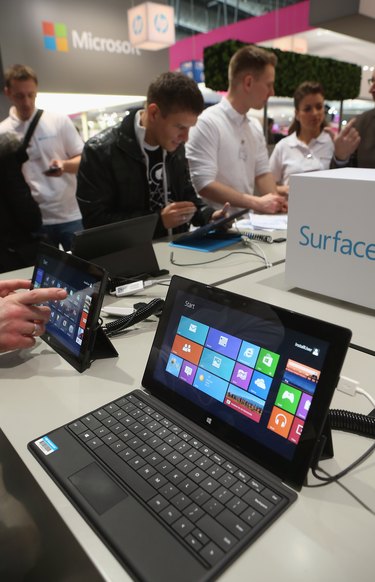
Lower-end modern computer graphics cards can handle playing back video and running desktop operations in the 1080p resolution on a single monitor. A higher-quality graphics card is not a requirement, but some very low-end cards with limited memory won't work with 1080p playback. Multi-monitor setups may require a mid-range graphics card to handle more than one screen at a 1080p or higher resolution, but a high-end card is still not a requirement. However, the requirements increase if you're handling HD video, desktop applications or playing graphics-heavy games.
Windows Requirements
Video of the Day

Modern graphics cards can meet system requirements so easily now that Microsoft only lists DirectX 9 compatibility as a requirement for a graphics card to run Windows 8. Windows 7 had higher video requirements to run the Aero desktop environment, which was dropped from Windows 8. Windows 7 can handle a 1080p resolution with a 128MB video card, which is covered with even the lowest-end video cards available for modern computers. Computers actually have been capable of handling near-1080p resolutions going back as far as Windows 95. A Windows 95 computer could run the 1280-by-1024 resolution with just 4MB of video memory. According to Intel, 64MB of video RAM is sufficient to handle a single 1080p monitor and 256MB of video RAM is sufficient to handle two 1080p monitors with all Aero features turned on.
Video of the Day
Video
Video-playback requirements depend on video format and resolution. Mid-level DirectX 9 video adapters can handle playing back a DVD or Blu-ray video in 1080p. Mid-range power video cards can handle MP4, MPG and AVI video playback in 1080p without much of a problem. Lower-end video cards may struggle playing in 1080p, but the newer the card is the more likely it will play video back without a problem. Any video card with more than 256MB of RAM should be able to playback in 1080p without any problem. However, Blu-ray software maker Cyberlink recommends having a video card with at least 512MB of RAM to ensure smooth Blu-ray playback. Additionally, video cards made before the Intel 965G, Nvida GeForce 7 series and Radeon X1600 series may struggle with Blu-ray playback.
FLV Exception
The FLV video format that's used frequently for streaming video does not play back through the video card, it plays back through the CPU. FLV playback is a mixed bag because it can play back in 1080p easily on a computer with a low-end video card and a fast CPU or play back poorly on a computer with a high-end video card and a slow CPU.
Gaming, Editing and Design
Graphics-heavy games, video-editing software and graphics-design applications all have substantially higher video card requirements than desktop and video playback at 1080p. The actual graphics card requirements vary between programs and resolutions. However, games are usually able to degrade other graphical aspects to handle running at a 1080p resolution. A mid-range or high-end video card may be required for 1080p use on high-end programs.
- Microsoft Windows: Windows 8 System Requirements
- Intel Graphics: System Hardware for Windows Vista Aero Glass Feature
- Microsoft Windows: What Is the Aero Desktop Experience?
- Intel: 3rd Generation Intel Core i5-3470 Processor
- Intel: Supported Graphics APIs and Features
- Microsoft Support: Description of Video Ram Required for Higher Resolutions
- Cyberlink: What Graphics Card do I Need to Play Blu-ray/Blu-ray 3D Disc and TrueTheater 3D on My Computer?